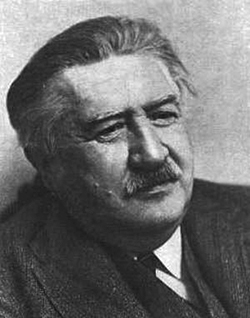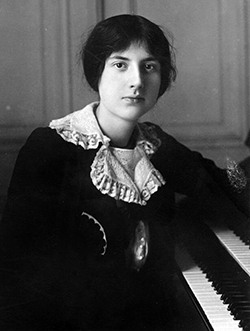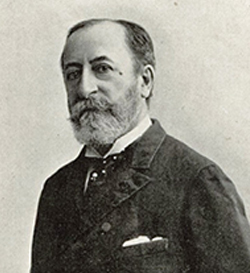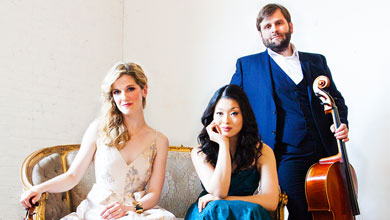Program
Josef Suk
Piano Trio in C minor, Op.2
Lili Boulanger
Deux Pièces en Trio
Camille Saint-Saëns
Piano Trio No. 2 in E minor, Op. 92
Neave Piano Trio
Since its formation in 2010, the Neave Trio has earned enormous praise for its engaging, cutting-edge performances. The Neave has performed at many esteemed concert series and at festivals worldwide, including Lincoln Center’s Mostly Mozart Festival, Carnegie Hall’s Weill Recital Hall, and the Samoylov and Rimsky Korsakov Museums’ Chamber Music Series. They have held residency positions at Brown University, University of Virginia, Bard College, San Diego State University, and many other institutions.
Program Notes
Josef Suk (1874-1935)
Piano Trio in C minor, Op. 2
Performance time: 15’
In 1874 the Chicago fire burned 47 acres of the city; first public zoo opens in Philadelphia.

Josef Suk (1874-1935)
Josef Suk was a Czech composer and violinist. From a young age he was trained in music by his father, Josef Suk Sr., who was the village choirmaster. His exceptional talent allowed him to be enrolled at the Prague Conservatory at age 11 where he first focused on violin. Eventually, he became a composition student of Antonin Dvořák and a friend of his family. In 1898 Josef married Dvořák’s daughter, Otile.
While he was at the Conservatory, he formed the world-famous Bohemian (Czech) Quartet with three of his fellow students and played second violin in the Quartet for most of his life. From 1922 Suk taught at the Prague Conservatory and served as its Director several times after 1924.
An odd and interesting note on Suk’s achievements is his winning an Olympic silver medal for music at the 1932 Olympic games in Los Angeles. Art competitions (architecture, literature, music, painting, and sculpture) for works inspired by sport-related themes were part of the program from 1912 to 1952.
The Op. 2 Piano Trio was initially composed while Suk was still a student (age 14-15). It was changed numerous times as he showed it to his teachers and accepted their recommendations. Its first public performance was in 1891 at the Conservatory.
The main theme in the opening Allegro is expressed by a dramatic series of piano chords against a striving melody in the strings. The slower second theme, introduced by the cello, is more lyrical. The second movement, Andante, is a relaxed and elegant folk dance followed by a very romantic second theme. The final movement, Vivace, is a highly original and syncopated dance with a driving energy followed by a march.
Click here for a performance of Piano Trio in C minor, Op. 2 by the Berlin Philharmonic Piano Trio.
Lili Boulanger (1893–1918)
Deux Pieces en Trio
Performance time: 15’
In 1893 the World’s Columbian Exposition opened in Chicago/debut of Ferris wheel and Cracker Jack; New Zealand becomes first country to grant woman suffrage.

Lili Boulanger (1893–1918)
Marie-Juliette Olga “Lili” Boulanger was born in 1893 into a musical family. Her father, Ernest Boulanger, 77 years old when she was born, was a teacher at the Paris Conservatoire and had won the Prix de Rome for composition. Lili’s grandfather on her father’s side had been a noted cellist and her grandmother was a singer.
Lili’s older sister, Nadia Boulanger, became a very influential teacher who had a remarkable impact on the development of modern music composition. Nadia was also the first woman to conduct many major orchestras in America and Europe. Lili herself was a musical prodigy, was the first woman to win the Prix de Rome for composition, and did so at age 19. Her musical accomplishments probably would have eclipsed those of her older sister had she not died at 24. After Lili died, Nadia stopped composing because she felt that Lili’s gifts as a composer exceeded hers.
At the age of 6 Lili had developed bronchial pneumonia which weakened her immune system and from which she never fully recovered. She died from intestinal tuberculosis. Thus, the young prodigy who sang, played piano, organ, violin, cello, and harp, and who was becoming a well-known composer suffered physical ailments throughout her short life.
Most of her compositions were written for voice and piano or voice and other instrumental combinations. The two pieces we will hear today are the last two works she composed before her death. The first, D’un matin de printemps, sparkles with the energy of Spring. The piece begins with the violin playing the melody accompanied by the piano. Next, the cello plays the melody and a conversation develops between the two instruments ending with a joyous glissando on the piano.
The second piece, D’un soir triste, is a striking contrast to the first. Although the title suggests a sad evening, the music itself suggests despair rather than simple sadness with its slow tempo, minor key, and focus on the lower range of the instruments.
Click here for a performance of Piano Trio No. 2 in E minor, Op. 92 by the Boulanger Trio.
Camille Saint-Saëns (1835–1921)
Piano Trio No. 2 in E minor, Op. 92
Performance time: 36’
In 1835 the first railroad in continental Europe opened in Belgium; the first attempted assassination of a U.S. President, Andrew Jackson, failed.

Camille Saint-Saëns (1835–1921)circa 1880.
Yet another child prodigy! Camille Saint-Saëns was not only a musical prodigy but a polymath. He was a composer, organist, pianist, musicologist, and conductor. He was also an astronomer, philosopher, poet, playwright, and an archeologist.
Because his mother did not want him to become noticed at a very young age, his first public recital was at age 10. After he played this recital to thunderous applause, he was quoted as saying, ”If you want an encore, I know all of Beethoven’s sonatas.”
He entered the Paris Conservatoire where organ studies were emphasized rather than pianistic studies, and he was a church organist for 20 years. His travels to Algeria and Egypt introduced Orientalism to his work. Although Saint-Saëns was a prolific composer, little of his work is performed today. We all know Danse Macabre and Carnival of the Animals. Those pieces reveal a delightful sense of humor at odds with his other works.
Because he lived for 86 years, Saint-Saëns lived when the musical giants in France were Berlioz and Meyerbeer. As a young man, he was very enthusiastic about most modern music of the day, particularly that of Schumann, Liszt, and Wagner. At the end of his life Debussy and Ravel introduced Impressionism, which Saint-Saens felt was decadent; he walked out of the premiere of the Rite of Spring (1913). His own compositions stayed within a conventional classical tradition. Thus, he became somewhat “outdated” in his own time.
The piece we will hear today is considered to be one of the greatest pieces of French chamber music. The first theme is dark and ominous in feeling while its second theme is more lyrical and romantic. This back and forth between darkness and light continues throughout the piece. The second movement has a sprightly theme which is interrupted by violent bursts of emotion. The third movement begins with the piano, then the cello enters with a romantic feeling which develops throughout. The fourth movement is graceful and light as the Grazioso poco allegretto marking indicates. The Finale begins quietly with a dark feeling. Midway, a canonic fugue begins, then the earlier sinister theme returns and leads to a dramatic conclusion.
Click here for a performance of Piano Trio No. 2 in E minor, Op. 92 by the Boulanger Trio.
—Program Notes by Gay K. Stanek
With thanks to Edition Silvertrust and Kai Christiansen.

Neave Piano Trio
Subscribe
Today!
Individual tickets may be purchased at the door (cash or check only) immediately before each concert.
All concerts are held at a private club just off Michigan Avenue in Chicago.
Call or email for more information
815-314-0681
office@ChicagoChamberMusicSociety.org